
Professor of Statistical Mechanics
My research group includes people in the Dept of Chemistry and in the Dept of Applied Maths and Theoretical Physics (DAMTP). We investigate questions from physics, chemistry and mathematics, using the theory of statistical mechanics to understand the behaviour of complex systems including biomolecules, glassy liquids, and soft matter. I am particularly interested in co-operative dynamics: for example, how do molecules move in crowded environments? What are the co-operative mechanisms for colloidal self-assembly, and the folding of biomolecules?
See also this page
Publications
Random pinning in glassy spin models with plaquette interactions
– Phys Rev E Stat Nonlin Soft Matter Phys
(2012)
85,
021120
(doi: 10.1103/physreve.85.021120)
Quantifying reversibility in a phase-separating lattice gas: an analogy with self-assembly.
– Physical Review E
(2012)
85,
021112
(doi: 10.1103/PhysRevE.85.021112)
Preparation and relaxation of very stable glassy states of a simulated liquid
– Physical Review Letters
(2011)
107,
275702
Analyzing mechanisms and microscopic reversibility of self-assembly
– Journal of Chemical Physics
(2011)
135,
214505
(doi: 10.1063/1.3662140)
Overview of different characterizations of dynamic heterogeneity
(2011)
9780199691470,
68
Mechanisms of kinetic trapping in self-assembly and phase transformation
– Journal of Chemical Physics
(2011)
135,
104115
(doi: 10.1063/1.3635775)
Predicting the self-assembly of a model colloidal crystal
– Soft Matter
(2011)
7,
6294
(doi: 10.1039/c1sm05456b)
Large deviations and ensembles of trajectories in stochastic models
– Progress of Theoretical and Experimental Physics
(2010)
184,
304
(doi: 10.1143/ptps.184.304)
Duality Symmetries in Driven One-Dimensional Hopping Models
– Progress of Theoretical Physics
(2010)
184,
200
(doi: 10.1143/ptps.184.200)
Finite-temperature critical point of a glass transition.
– Proceedings of the National Academy of Sciences
(2010)
107,
12793
(doi: 10.1073/pnas.1006306107)
- <
- 11 of 14
